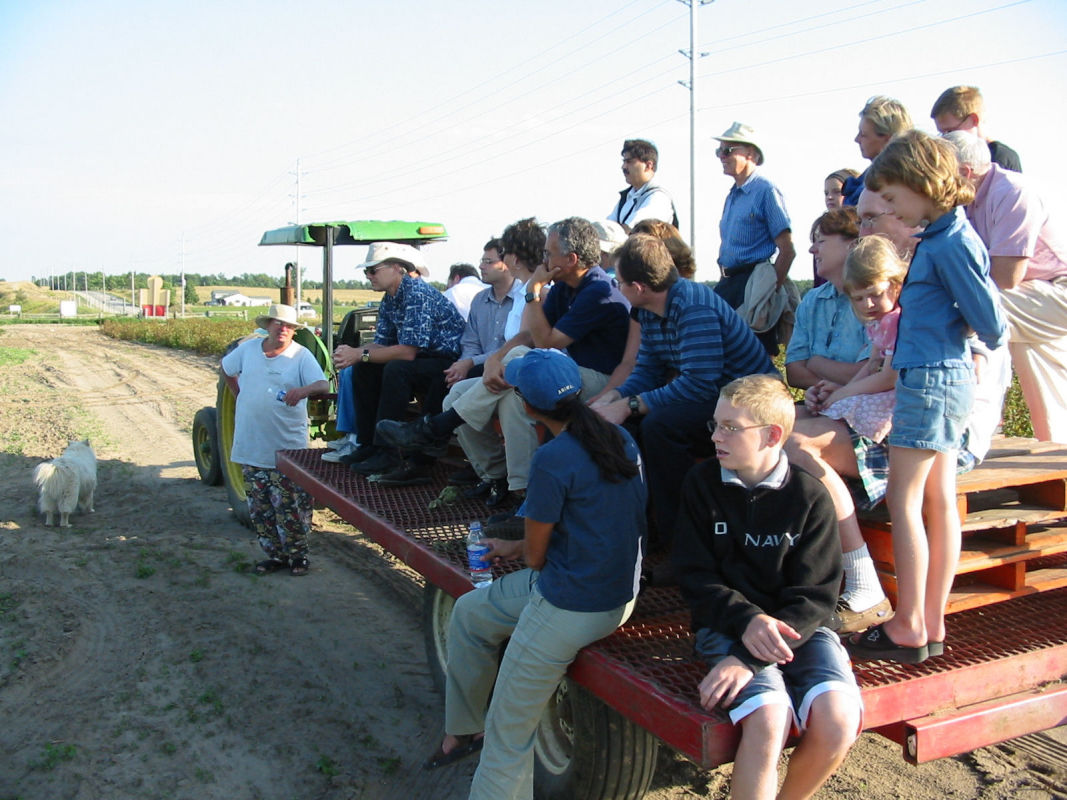My friend Farmer Jeff e-mailed me this morning. He’s not doing so well, but still has fire in his belly and the Oregon strawberry outbreak prompted him to write.
Jeff was a pioneer in fruit and vegetable growing in southern Ontario. I’m sure he got a chuckle when he heard that Monsanto announced last week it was going to start selling a consumer-oriented herbicide-tolerant Bt sweet corn. Jeff was growing, labeling and selling Syngenta’s Bt sweet corn over a decade ago (that’s Jeff, in the white T-shirt and banana pants doing what he loves — talking farming).
But Jeff always had a receptive ear for my microbial food safety rants and he always tried to fit my theories into the practicalities of farm life: especially strawberries.
Jaquith Strawberry Farm in rural Washington County, Oregon is a 35-acre strawberry producer, has been identified as the source of an E. coli O157:H7 that has killed one and  sickened 15; four people went to the hospital, including two people who suffered kidney failure.
sickened 15; four people went to the hospital, including two people who suffered kidney failure.
The farm sold potentially tainted fresh strawberries to buyers who in turn distributed them to roadside stands and farmers markets in Multnomah, Washington, Clackamas, Yamhill and Clatsop counties.
The last of the berries were sold Aug. 1, but health officials are worried that consumers might have stored some of them in the freezer or turned them into uncooked jam.
Anyone who bought strawberries from a stand north of Marion County and as far east as Clackamas County should throw them out. They were sold in unmarked containers without labels.
According to reports in The Oregonian, once it became apparent an outbreak was emerging, epidemiologists kicked into high gear, grilling patients on what they had eaten and where to find a common link. Many said they bought strawberries from a roadside stand.
Next, epidemiologists drove to homes to collect berries from freezers for testing. They quizzed roadside stands where patients had shopped. Those questions turned up Jaquith Strawberry Farm as the likely source of the contamination.
William Keene, senior epidemiologist with Oregon Public Health, suspects the source might be deer he saw roaming through the fields. Scientists took more than 100 soil and other samples from the farm this weekend and sent them to a lab outside Seattle for testing, hoping to confirm the source of E. coli O157:H7.
In the scramble to unravel an E. coli outbreak traced to strawberries, Oregon food safety experts have spent days poring over sales information.
Jaquith Strawberry Farm provided hand-written lists of buyers, sometimes first names only, to food safety specialists. Officials then worked the phones, calling all the people on the list. .jpg) But the calls didn’t stop there. What they discovered is that the berries sometimes changed hands, traveling from buyer to farmers markets and then to consumers.
But the calls didn’t stop there. What they discovered is that the berries sometimes changed hands, traveling from buyer to farmers markets and then to consumers.
And sometimes farmers bought the berries and resold them as their own crop, a practice that is illegal.
"Apparently, it is more common than we thought," said Vance Bybee, head of food safety at Oregon Department of Agriculture.
Deer, like other ruminants, are the natural reservoirs for shiga-toxin producing E. coli like O157:H7 (that’s right, Food Inc. fans, it’s not just feedlot cattle). Deer were the suspected source in the 1996 E. coli O157:H7 in unpasteurized Odwalla juice that sickened 76 and killed a 16-month-old. Deer meat has also been involved in at least two recognized E. coli outbreaks.
My friend Jeff says the pickers should have noticed the deer poop, or at least been aware, and as another farmer friend would suggest, “shoot the f***ers.”
Jeff says agriculture is going backwards.
A table of strawberry-related outbreaks is available at http://bites.ksu.edu/strawberries-related-outbreaks. The overwhelming majority of these outbreaks are related to handling, not growing. But, stuff happens.
 deer were the source of contamination of the strawberries," Keene said.
deer were the source of contamination of the strawberries," Keene said. 
.jpg) But the calls didn’t stop there. What they discovered is that the berries sometimes changed hands, traveling from buyer to farmers markets and then to consumers.
But the calls didn’t stop there. What they discovered is that the berries sometimes changed hands, traveling from buyer to farmers markets and then to consumers.